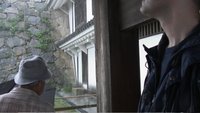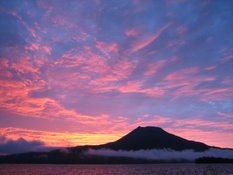The final day of Chuck's stay, we went to a Hanshin Tigers' baseball game. The Tigers could be seen as the Chicago Cubs of Japanese Baseball: affable, long-suffering, and play in a vintage stadium. Almost all Japanese baseball teams are named after the companies that own them, instead of the city that hosts them. You can either see that as a corporate sell-out or transparency of the nature of professional sports. The Tigers' stadium is actually in my town, Nishinomiya.
Koshien Stadium was built in 1924. Babe Ruth played there in a 1934 exhibition game. I had been meaning to get tickets for some time, but the task of ordering over the phone in Japanese was very difficult. A few weeks before I bicycled down to the ivy-covered stadium to buy tickets in person, only to find out that the ticket office was closed at that hour.
So it got down to 3 days before the game. We went out for coffee with a fellow teacher of mine at school. He offered to help us get the tickets. I had heard that one could buy tickets at a convenience store, but never saw any signs to that effect. It turns out that there is an all-in-one ATM-type machine for buying tickets for any event. But it was too soon to the day to buy tickets for the game. Chuck and I would have to stake out the stadium ticket booth to get tickets. It opened at 9am we thought.
To widen their fan base, Hanshin Tigers play a few games every year in the Osaka Dome (now the Kyocera Dome). On the night of the game we attended, that's where the Tigers were playing.

So we had to find our way to the spaceship to get tickets to go inside. We didn't have any trouble finding the stadium, it was the wait for the tickets that took all afternoon. The box office wouldn't open until 4, the game starts at 6:30. What did we do in the meantime?
My girlfriend kept telling me that we couldn't go to a baseball game without cheer goods. What are those? The officially-licensed merchandise of every imaginable kind to show your team support. One could easily get carried away with the hats, jerseys, bats, fans, cup holders, and noise makers sold in the store. Chuck and I decided to buy one plastic bat each so we could take turns knocking both of them together to make noise for our favorite player. And "lucky seven" balloons for the 7th inning stretch. A fan with the picture of my favorite player, Akihiro Yano #39, on it. And I caved in and got a sun visor (even thought the Osaka Dome is, well, a dome) because I need a new one for jogging in the summer, too.
There's not much of a residential neighborhood around the Dome, so Chuck and I walked around the food courts and browsed the shops. It was a hot day and the box office was the in open sun, so we held out from waiting in line for as long as we could. I wanted to include some sightseeing in our day, but Chuck didn't want to take any chances on not getting tickets for the game, so we stayed close to the Dome. A wise decision. However, the line for the tickets wasn't too long.

On this day, the Tigers were playing the Yokohama Bay Stars. Chuck and I wanted to get good seats, so we thought the left field tickets, which were 400 yen more than the right field tickets, would be better. We were quickly corrected by our comrades in line that the left field tickets are for the visiting team's fans. Evidently there's a profit markup on the visitors! Unlike MLB in the USA, a team's fans stick together so they can sing the songs and chant the cheers in unison instead of being spread throughout the stadium. Finally we got the tickets. Now we had 2.5 more hours to kill before the first pitch! Chuck and I decided to go to our seats, watch batting practice, and see the stadium fill up. My girlfriend, who'd been to several Hiroshima Carp games, told me that we wouldn't sit down the entire game because of the peer pressure to cheer for the home team. Chuck was actually looking forward to that feature because the seats were so close together with such small leg room, that his 6'3" frame was cramped without anyone sitting next to him!
Gradually the stadium began to fill. No national anthem was sung. Just the Hanshin Tigers' song:
Rokko Oroshi (The Wind of Mount Rokko). We got to our feet, only to be surprised after a few minutes when most everyone sat down. What's this? Lazy fans? No, first off, the Bay Stars were up and no Tigers-loving fan would cheer for the visiting batters. When the Tigers were up, still no standing ovation. We were in the cheap seats where no TV cameras dare to go, so we weren't in jeopardy of being publicly exposed as unenthusiastic fans. As I would later learn from Gilda, maybe Hiroshima Carp fans feel obligated to stand and cheer the entire game because their team is so bad, they need all the help they can get. Tigers are first in the standings, so we can take it easy!
Still, in the 4th inning we were down by a few runs, so the fans got all genki (Japanese for powerful, energetic) and did some non-stop cheering until we rallied and took the lead. We'd hold it for the rest of the night.
All that cheering made us hungry, so this is a good time to tell what there is to eat at Japanese baseball games. Yes, you can have hot dogs and beer and popcorn. But the menu similarities with USA end there. Out in the stands, they have they chatty vendors coming up and down the aisle.

Adkins Diet has taken off over here because the hot dogs are served on a stick instead of a bun;) Vendors carry a keg on their back to give beer refills instead of dispensing another cup. Nifty, eh? Everybody seems to share in the stands. Our seat neighbors gave us some sushi, grilled chicken, and edamame green beans to nibble on. Chuck and I shared some good ole American popcorn. I like dried squid, so I shared some of that, too. Always the adventurous one, Chuck tried it too. What a trooper.
Instead of singing "take me out to the ballgame" during the 7th inning stretch, Hanshin Tigers fans let off 50,000 balloons simultaneously! This is known as "lucky seven". Evidently there's some sexual overtones to this phrase in English, but I am not familiar with it.

The sight of all those balloons in the air accompanied by the screeching noise like fireworks is really exciting. If you haven't already done so, check out the video at the top of the blog to watch Lucky Seven for yourself. As a side note, I've found some other Nishinomiya bloggers online. One of them,
Shiona, just went to her first Tigers' game, too.
By 9pm, the Tigers had the game in hand. Chuck was leaving the next day, so we decided to go home at the bottom of the eighth inning to beat the crowds. We proudly wore our cheer goods through the subway station and in the streets as we made our way home. Experiencing a familiar event through a different culture's lens adds another level of insight to it. Chuck and I understood a little bit more about Japan after our exciting foray into the world of Japanese baseball. Thanks for reading this far. Stay tuned for postcards from my trip to Hokkaido, which begins July 23rd and continues to August 2nd. Genki de!

 The neighborhoods around the Shijo area of Kyoto host the floats, which families opening their homes to display heirlooms of calligraphy, tapestries, and second floor access to enter the floats. Here is an example of the special furnishings on display.
The neighborhoods around the Shijo area of Kyoto host the floats, which families opening their homes to display heirlooms of calligraphy, tapestries, and second floor access to enter the floats. Here is an example of the special furnishings on display.  On the ground, merchants set up stalls to sell food, candy, toys, and souvenirs of the event. With our special host, we were allowed access to some of these homes. It was very special for me to see traditional urban homes because I live in foreigner housing in Nishinomiya. The thin, sliding doors between rooms were open wide to allow the slightest of breezes to cool off visitors.
On the ground, merchants set up stalls to sell food, candy, toys, and souvenirs of the event. With our special host, we were allowed access to some of these homes. It was very special for me to see traditional urban homes because I live in foreigner housing in Nishinomiya. The thin, sliding doors between rooms were open wide to allow the slightest of breezes to cool off visitors.  There must have been at least a million people walking the streets. Since Japan has no outdoor air conditioning (come on! what's with this country?;) all the big companies were handing out fans to keep people cool. I must have collected 8 of them that day. So as I wander around the area, I'm snapping photos. With all my excitement to take pictures of events leading up to the dark, my camera ran out of batteries! Aargh! I managed to get two pictures of the lanterns. Here's the best one.
There must have been at least a million people walking the streets. Since Japan has no outdoor air conditioning (come on! what's with this country?;) all the big companies were handing out fans to keep people cool. I must have collected 8 of them that day. So as I wander around the area, I'm snapping photos. With all my excitement to take pictures of events leading up to the dark, my camera ran out of batteries! Aargh! I managed to get two pictures of the lanterns. Here's the best one. 




















